Changing Trends of NDVI and Their Responses to Climatic Variation in Different Types of Grassland in Inner Mongolia from 1982 to 2011
Abstract
:1. Introduction
2. Materials and Methods
2.1. Study Area
2.2. Sources and Data Processing
2.2.1. Grassland Types
2.2.2. Meteorological Data
2.2.3. NDVI Maximum Value Composite Procedure
2.2.4. Statistical Analysis
3. Results
3.1. Spatial and Temporal Variation in NDVI
3.2. Relationship between NDVI and Temperature
3.3. Relationship between Precipitation and NDVI
4. Discussion
5. Conclusions
Author Contributions
Funding
Conflicts of Interest
References
- Nemani, R.R.; Keeling, C.D.; Hashimoto, H.; Jolly, W.M.; Piper, S.C.; Tucker, C.J. Climate-driven increases in global terrestrial net primary production from 1982 to 1999. Science 2003, 300, 1560–1563. [Google Scholar] [CrossRef] [PubMed]
- Woodward, F.I.; McKee, I.F. Vegetation and climate. Environ. Int. 1991, 17, 535–546. [Google Scholar] [CrossRef]
- Horion, S.; Cornet, Y.; Erpicum, M.; Tychon, B. Studying interactions between climate variability and vegetation dynamic using a phenology based approach. Int. J. Appl. Earth Obs. Geoinf. 2013, 20, 20–32. [Google Scholar] [CrossRef]
- Piao, S.L.; Mohammat, A.; Fang, J.Y.; Cai, Q.; Feng, J.M. NDVI-based increase in growth of temperate grasslands and its responses to climate changes in China. Glob. Environ. Chang. 2006, 16, 340–348. [Google Scholar] [CrossRef]
- Gao, J.G.; Zhang, Y.L.; Liu, L.S.; Wang, Z.F. Climate change as the major driver of alpine grasslands expansion and contraction: A case study in the Mt. Qomolangma (Everest) National Nature Preserve, southern Tibetan Plateau. Quat. Int. 2014, 336, 108–116. [Google Scholar] [CrossRef]
- Yang, L.M.; Wylie, B.K.; Tieszen, L.L.; Reed, B.C. An analysis of relationships among climate forcing and time-integrated NDVI of grasslands over the US northern and central Great Plains. Remote Sens. Environ. 1998, 65, 25–37. [Google Scholar] [CrossRef]
- Cui, L.L.; Shi, J.; Xiao, F.J.; Fan, W.Y. Variation trends in vegetation NDVI and its correlation with climatic factors in eastern China. Resour. Sci. 2010, 32, 124–131. (In Chinese) [Google Scholar]
- Zhao, X.; Tan, K.; Zhao, S.; Fang, J. Changing climate affects vegetation growth in the arid region of the northwestern China. J. Arid Environ. 2011, 75, 946–952. [Google Scholar] [CrossRef]
- Yang, Y.; Wang, Z.Q.; Li, J.L.; Gang, C.C.; Zhang, Y.Z.; Zhang, Y.; Odeh, I.; Qi, J.G. Comparative assessment of grassland degradation dynamics in response to climate variation and human activities in china, mongolia, pakistan and uzbekistan from 2000 to 2013. J. Arid Environ. 2010, 135, 164–172. [Google Scholar] [CrossRef]
- Polley, H.W.; Briske, D.D.; Morgan, J.A.; Wolter, K.; Bailey, D.W.; Brown, J.R. Climate change and north american rangelands: Trends, projections, and implications. Rangel. Ecol. Manag. 2013, 66, 493–511. [Google Scholar] [CrossRef]
- Mckeon, G.M.; Stone, G.S.; Syktus, J.I.; Carter, J.O.; Flood, N.R.; Ahrens, D.G.; Bruget, D.N.; Chilcott, C.R.; Cobon, D.H.; Cowley, R.A.; et al. Climate change impacts on Australia’s rangeland livestock carrying capacity: A review of issues. Rangel. J. 2009, 31, 1–29. [Google Scholar] [CrossRef]
- Han, J.G.; Zhang, Y.J.; Wang, C.J.; Bai, W.M.; Wang, Y.R.; Han, G.D.; Li, L.H. Rangeland degradation and restoration management in china. Rangel. J. 2008, 30, 233. [Google Scholar] [CrossRef]
- Wang, Z.; Deng, X.; Song, W.; Li, Z.; Chen, J. What is the main cause of grassland degradation? A case study of grassland ecosystem service in the middle-south Inner Mongolia. Catena 2017, 150, 100–107. [Google Scholar] [CrossRef]
- Zheng, W.; Zhu, J.Z. Analysis of desertification process and driving force factors in grassland ecosystem of Xinjiang. Pratac. Sci. 2012, 29, 1340–1351. (In Chinese) [Google Scholar]
- Chuai, X.W.; Huang, X.J.; Wang, W.J.; Bao, G. NDVI, temperature and precipitation changes and their relationships with different vegetation types during 1998–2007 in Inner Mongolia, China. Int. J. Climatol. 2013, 33, 1696–1706. [Google Scholar] [CrossRef]
- Ma, Y.L.; Yu, W.H.; Fang, X.Q. Change of grass growth in the Hulunbuir steppe in response to global warming. Arid Land Geogr. 2004, 27, 29–34. (In Chinese) [Google Scholar]
- Gu, Z.H.; Chen, J.; Shi, P.J.; Xu, M. Correlation analysis of NDVI difference series and climate variables in Xilingole steppe from 1983 to 1999. Acta Phytoecol. Sin. 2005, 29, 753–765. (In Chinese) [Google Scholar]
- Li, X.B.; Chen, Y.H.; Zhang, Y.X.; Fan, Y.D.; Zhou, T.; Xie, F. Impact of Climate Change on Desert in Northern China. Adv. Earth Sci. 2002, 2, 254–261. (In Chinese) [Google Scholar]
- Cao, X.J.; Gao, Q.Z.; Ganjurjav, H.; Liang, Y.; Li, W.H.; Hu, G.Z. Influence of climatic factors on variation in the Normalised Difference Vegetation Index in Mongolian Plateau grasslands. Rangel. J. 2017, 40. [Google Scholar]
- Yang, T.; Li, P.; Wu, X.; Hou, X.; Liu, P.; Yao, G. Assessment of vulnerability to climate change in the Inner Mongolia steppe at a county scale from 1980 to 2009. Rangel. J. 2014, 36, 545–555. [Google Scholar] [CrossRef]
- IPCC. Summary for Policymakers. In Climate Change 2013: The Physical Science Basis. Contribution of Working Group I to the Fifth Assessment Report of the Intergovernmental Panel on Climate Change; Stocker, T.F., Qin, D., Plattner, G.-K., Tignor, M., Allen, S.K., Boschung, J., Nauels, A., Xia, Y., Bex, V., Midgley, P.M., Eds.; Cambridge University Press: Cambridge, UK; New York, NY, USA, 2013. [Google Scholar]
- Animal Husbandry Department, Ministry of Agriculture of the People’s Republic of China. Monitoring Report of Grassland in China; Animal Husbandry Department, Ministry of Agriculture of the People’s Republic of China: Beijing, China, 2014. (In Chinese)
- Li, B.; Yong, S.P.; Zeng, S.D.; Cui, H.T. Regionalization map of the Inner Mongolia Autonomous region. Acta Phytoecol. Geobot. Sin. 1990, 14, 55–62. (In Chinese) [Google Scholar]
- Zhang, C.Q.; Chi, Y. Simulation of growth dynamics of four plants in the typical steppe of Inner Mongolia in growing season. Acta Ecol. Sin. 2007, 27, 3618–3629. [Google Scholar]
- Zhang, Q.Y.; Wu, S.H.; Zhao, D.S.; Dai, E.F. Responses of growing season vegetation changes to climatic factors in Inner Mongolia grassland. J. Nat. Resour. 2013, 28, 754–764. (In Chinese) [Google Scholar]
- Guo, L.; Wu, S.; Zhao, D.; Yin, Y.; Leng, G.; Zhang, Q. NDVI based vegetation change in Inner Mongolia from 1982 to 2006 and its relationship to climate at the biome scale. Adv. Meteorol. 2014. [Google Scholar] [CrossRef]
- Di, L.; Rundquist, D.C.; Han, L. Modelling relationships 45between NDVI and precipitation during vegetative growth cycles. Int. J. Remote Sens. 1994, 2121–2136. [Google Scholar] [CrossRef]
- Gessner, U.; Naeimi, V.; Klein, I.; Kuenzer, C.; Klein, D.; Dech, S. The relationship between precipitation anomalies and satellite-derived vegetation activity in Central Asia. Glob. Planet. Chang. 2013, 110, 74–87. [Google Scholar] [CrossRef]
- Xin, Z.B.; Xu, J.X.; Zheng, W. Spatiotemporal variations of vegetation cover on the chinese loess plateau (1981–2006): Impacts of climate changes and human activities. Sci. China Ser. D Earth Sci. 2008, 51, 67–78. (In Chinese) [Google Scholar] [CrossRef]
- Jiang, D.M.; Liu, Z.M.; Kou, Z.W.; Alamusa, M.S.; Li, R.P. Ecological environment and its sustainable management of horqin steppe—A report on the survey of horqin sandy land. Chin. J. Ecol. 2004, 23, 179–185. (In Chinese) [Google Scholar]
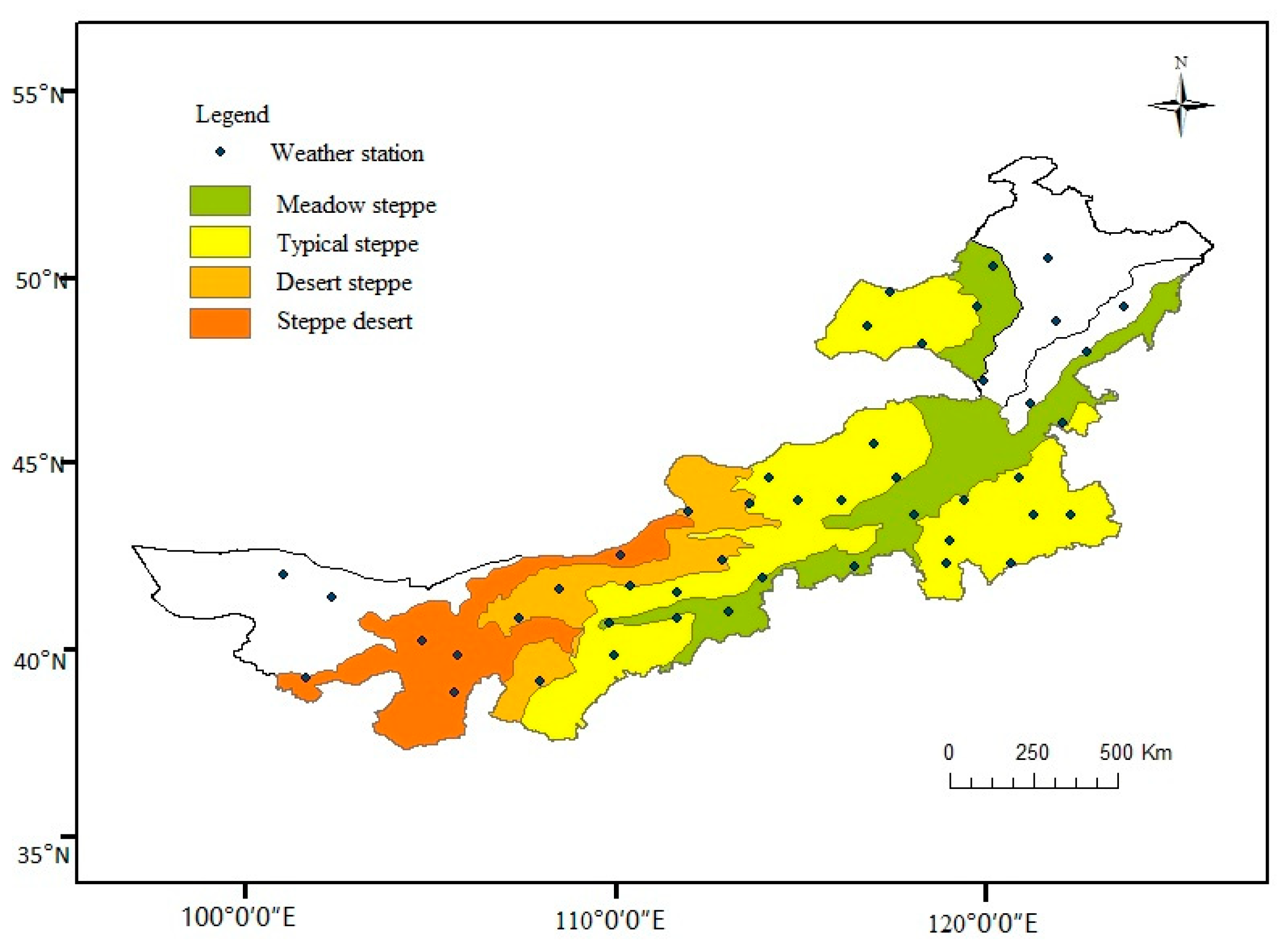
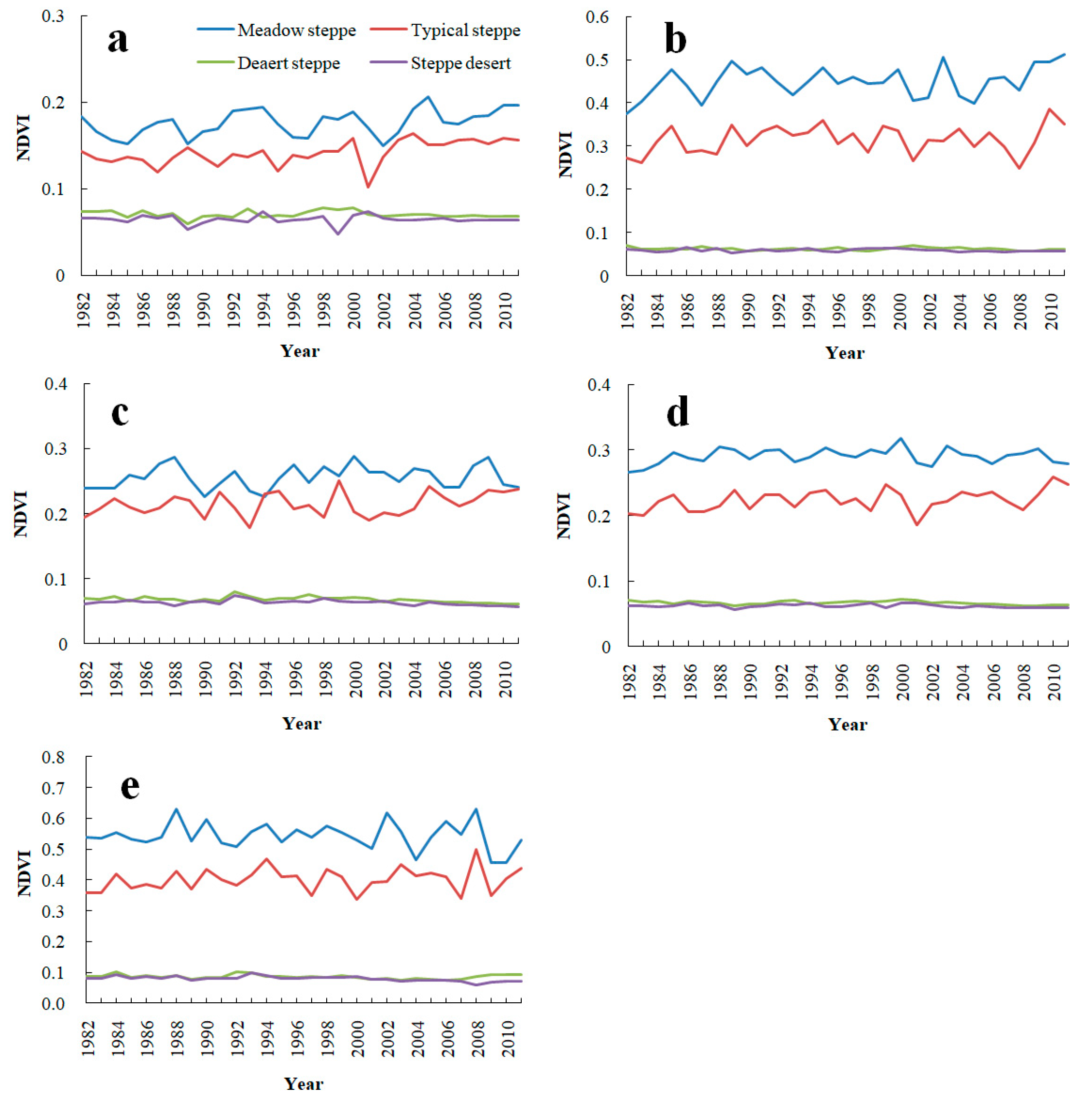
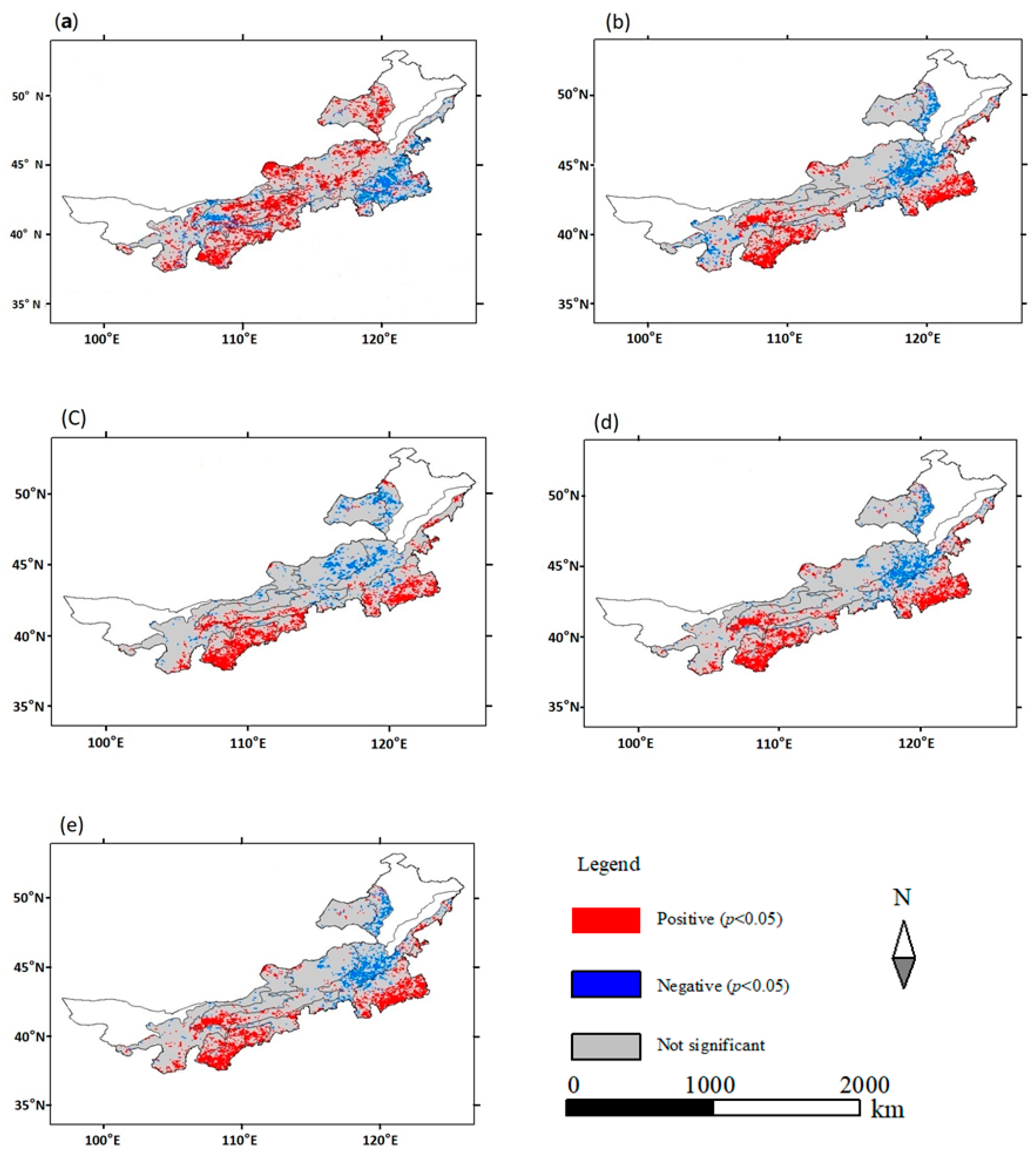
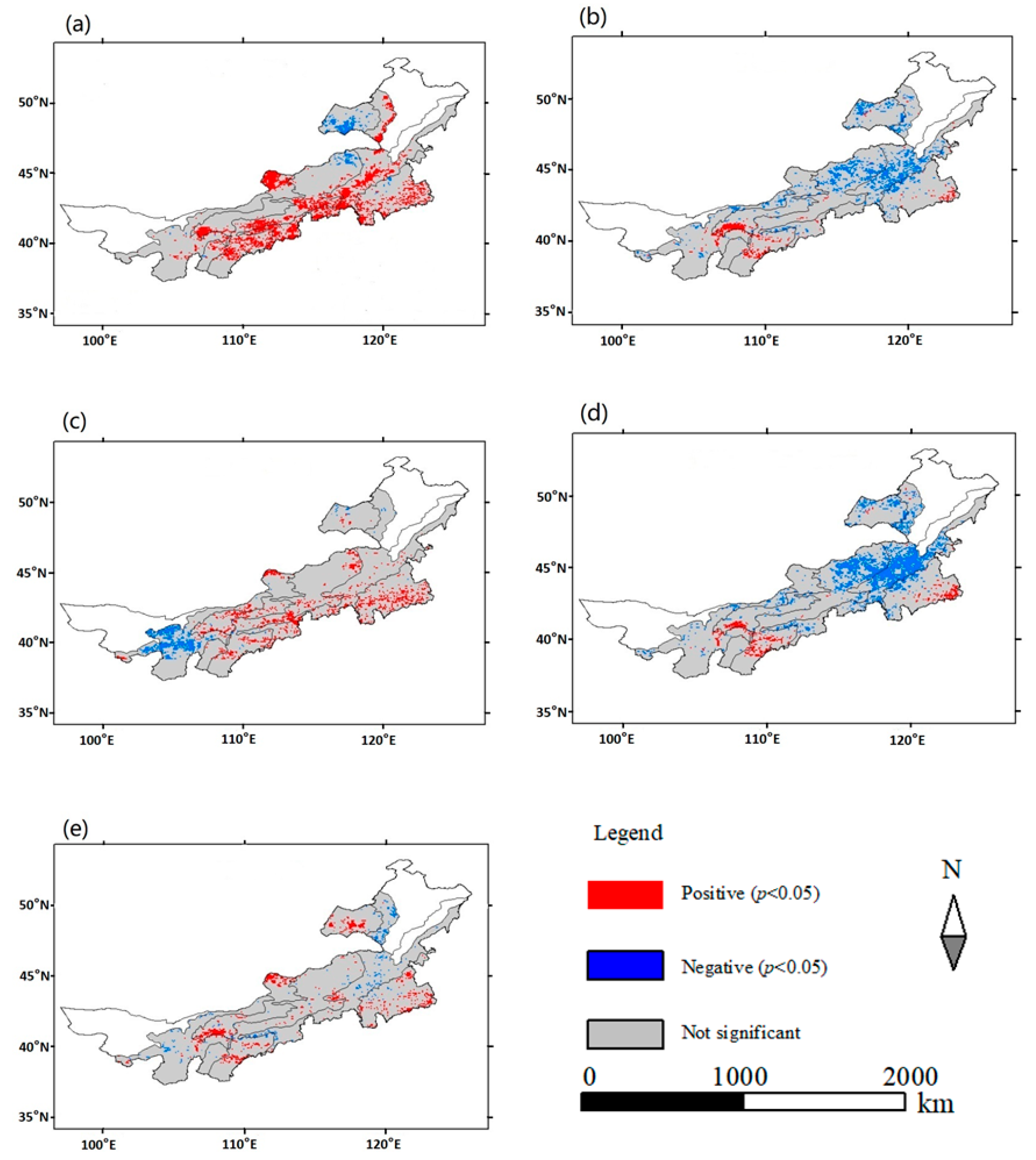
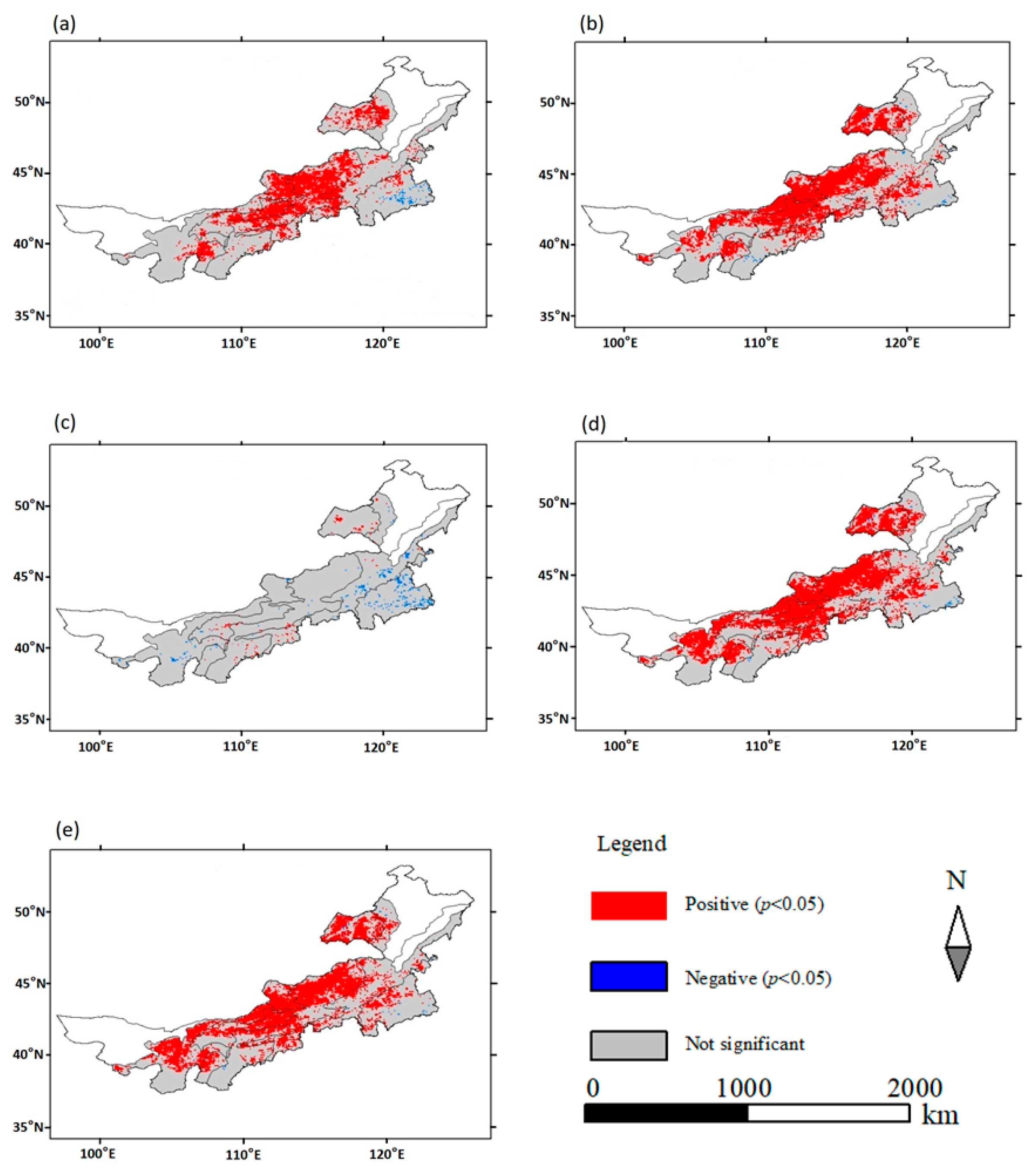
| Steppe Type | Intra-Annual Time Period | Increasing Trend (p < 0.05) | Decreasing Trend (p < 0.05) | No Significant Trend |
|---|---|---|---|---|
| Meadow steppe | Spring | 20 | 4 | 76 |
| Summer | 4 | 27 | 69 | |
| Autumn | 7 | 14 | 79 | |
| Growing season | 4 | 28 | 68 | |
| Full year | 4 | 28 | 68 | |
| Typical steppe | Spring | 18 | 13 | 69 |
| Summer | 21 | 3 | 76 | |
| Autumn | 20 | 10 | 70 | |
| Growing season | 21 | 4 | 75 | |
| Full year | 22 | 4 | 74 | |
| Desert steppe | Spring | 30 | 7 | 63 |
| Summer | 20 | <1 | 79 | |
| Autumn | 13 | 2 | 85 | |
| Growing season | 20 | <1 | 79 | |
| Full year | 20 | <1 | 79 | |
| Steppe desert | Spring | 10 | 5 | 85 |
| Summer | 4 | 9 | 87 | |
| Autumn | 5 | 2 | 93 | |
| Growing season | 5 | 2 | 93 | |
| Full year | 5 | 2 | 93 |
| Steppe Type | Intra-Annual Time Period | Positive (p < 0.05) | Negative (p < 0.05) | No Correlation |
|---|---|---|---|---|
| Meadow steppe | Spring | 25 | <1 | 74 |
| Summer | <1 | 23 | 76 | |
| Autumn | 4 | <1 | 95 | |
| Growing season | <1 | 40 | 59 | |
| Full year | 1 | 7 | 92 | |
| Typical steppe | Spring | 17 | 5 | 78 |
| Summer | 3 | 13 | 84 | |
| Autumn | 10 | <1 | 89 | |
| Growing season | 4 | 18 | 78 | |
| Full year | 6 | <1 | 93 | |
| Desert steppe | Spring | 19 | <1 | 80 |
| Summer | 7 | 3 | 90 | |
| Autumn | 8 | <1 | 91 | |
| Growing season | 4 | 3 | 93 | |
| Full year | 10 | <1 | 89 | |
| Steppe desert | Spring | 2 | <1 | 97 |
| Summer | 2 | 6 | 92 | |
| Autumn | 2 | 28 | 70 | |
| Growing season | 1 | 5 | 94 | |
| Full year | 1 | 3 | 96 |
| Steppe Type | Intra-Annual Time Period | Positive (p < 0.05) | Negative (p < 0.05) | No Correlation |
|---|---|---|---|---|
| Meadow steppe | Spring | 18 | 0 | 82 |
| Summer | 19 | 0 | 81 | |
| Autumn | 1 | 3 | 96 | |
| Growing season | 29 | 0 | 71 | |
| Full year | 21 | 0 | 79 | |
| Typical steppe | Spring | 35 | 1 | 64 |
| Summer | 43 | 0 | 57 | |
| Autumn | 1 | 3 | 96 | |
| Growing season | 47 | 0 | 53 | |
| Full year | 42 | 0 | 58 | |
| Desert steppe | Spring | 50 | 0 | 50 |
| Summer | 56 | 0 | 44 | |
| Autumn | 1 | 0 | 99 | |
| Growing season | 57 | 0 | 43 | |
| Full year | 55 | 0 | 45 | |
| Steppe desert | Spring | 8 | 0 | 92 |
| Summer | 35 | 0 | 65 | |
| Autumn | 0 | 2 | 98 | |
| Growing season | 48 | 0 | 52 | |
| Full year | 47 | 0 | 53 |
© 2019 by the authors. Licensee MDPI, Basel, Switzerland. This article is an open access article distributed under the terms and conditions of the Creative Commons Attribution (CC BY) license (http://creativecommons.org/licenses/by/4.0/).
Share and Cite
Yang, J.; Wan, Z.; Borjigin, S.; Zhang, D.; Yan, Y.; Chen, Y.; Gu, R.; Gao, Q. Changing Trends of NDVI and Their Responses to Climatic Variation in Different Types of Grassland in Inner Mongolia from 1982 to 2011. Sustainability 2019, 11, 3256. https://doi.org/10.3390/su11123256
Yang J, Wan Z, Borjigin S, Zhang D, Yan Y, Chen Y, Gu R, Gao Q. Changing Trends of NDVI and Their Responses to Climatic Variation in Different Types of Grassland in Inner Mongolia from 1982 to 2011. Sustainability. 2019; 11(12):3256. https://doi.org/10.3390/su11123256
Chicago/Turabian StyleYang, Jie, Zhiqiang Wan, Suld Borjigin, Dong Zhang, Yulong Yan, Yali Chen, Rui Gu, and Qingzhu Gao. 2019. "Changing Trends of NDVI and Their Responses to Climatic Variation in Different Types of Grassland in Inner Mongolia from 1982 to 2011" Sustainability 11, no. 12: 3256. https://doi.org/10.3390/su11123256
APA StyleYang, J., Wan, Z., Borjigin, S., Zhang, D., Yan, Y., Chen, Y., Gu, R., & Gao, Q. (2019). Changing Trends of NDVI and Their Responses to Climatic Variation in Different Types of Grassland in Inner Mongolia from 1982 to 2011. Sustainability, 11(12), 3256. https://doi.org/10.3390/su11123256




